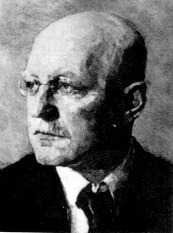| Profile | Major Works | Resources |
Arthur Spiethoff, 1873-1957

A student of Gustav Schmoller, Arthur Spiethoff is one of the few members of the German Historical School to make a substantial impact on mainstream economics. This impact was in the field of business cycle theory. Spiethoff's theory of cycles (1902, 1903, 1923) built upon that of Tugan-Baranovsky's overinvestment theory and nudged the theory along by giving credit, the heart of the overinvestment theory, an endogenous character through innovation. Spiethoff's theory was later used with much profit by Schumpeter and Cassel.
Spiethoff also participated in the Methodenstreit that pitted the German Historical School against the Austrian School. However, while at Bonn in the 1920s, Spiethoff crossed paths with Joseph Schumpeter and the two supposedly got on quite productively. Although Spiethoff's famous "economic styles" argument was for a reconciliation between the theoretical and empirical methods, his heart was inevitably on the side of the German Historical School (1932, 1952, 1953).
Originating from Dusseldorf, Arthur August Caspar Spiethoff enrolled at the University of Berlin in 1893, studying economics under Adolph Wagner and Gustav von Schmoller. Graduating in 1899, Spiethoff stayed on in Berlin, assisting Schmoller in in the editing of Schmollers Jahrbuch (JGVV), and writing his doctorate thesis on business cycle theory (1905). His habilitation thesis was finished in 1907, and Spiethoff was subsequently appointed to the chair in political economy at University of Prague, succeeding Alfred Weber. In 1918, Spiethoff moved to the University of Bonn. Spiethoff was joined by Schumpeter in 1925, and they worked alongside each other at Bonn. Spiethoff is often credited for turning Schumpeter on to cycle research.
Spiethoff is also sometimes credited as an independent inventor of Aftalion's accelerator theory of investment.
Initially supportive of the Nazi regime. Spiethoff remained at Bonn after 1933, until his retirement in 1939.
|
Major works of Arthur Spiethoff
|
HET
|
|
Resources on Arthur Spiethoff
|
All rights reserved, Gonçalo L. Fonseca
